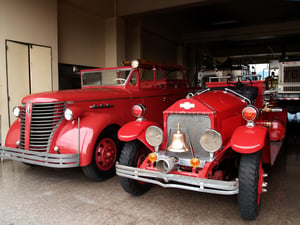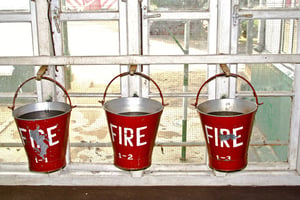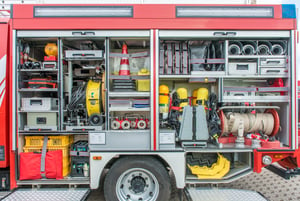
For thousands of years, societies have struggled with the problem of extinguishing fires.
Today, firefighters with stations located throughout the area seems like a no-brainer, but it wasn’t always the case. For many centuries, it was a challenge to even get water to where the fire was happening.
In this blog, we’re talking about the history of putting out fires – from the first firefighting companies to the evolution of the firetrucks we think of today.
The First Firefighters
Records of firefighting go back as far as ancient Egypt, but true fire prevention in the United States dates back to 1630, in Boston. During this year a notice went out, outlawing chimneys built with wood. This was one of the first recognized fire prevention methods on record in the U.S.
As far as actual firefighters, in 1736, Benjamin Frankley asked readers of his “Pennsylvanian Gazette” to establish firefighting companies in their communities – a fairly novel idea at the time. In fact, the first dedicated fire company was established that same year in Pennsylvania, and it was entirely volunteer. In the beginning, these volunteer fire companies were often as much social clubs as actual service providers, and they could be unreliable. This became an issue as communities and cities grew bigger and fires more frequent, and it became clear that firefighting needed to become a paid profession.
In 1853, the first professional fire department in America was established in Cincinnati. In following years, other cities followed suit, eventually expanding to the wide network of firehouses that we think of today.
The Evolution of Equipment

Firefighting equipment has changed drastically over the centuries, from simple structures with buckets of water and pipes with holes, to the fully equipped fire engines we think of today.
Steam fire engines first came on the scene in London in 1829, but they had some challenges. Namely, they were incredibly hard to transport because they were so heavy, and the engine was needed to pump the water vs. power the engine like a car. Usually, horses would pull these steam engines during the 1800s. This is when dalmatians became associated with firehouses. They were good companions to the horses, and they would help rouse the horses if the alarms went off to signal a fire.
In 1910, gasoline engines were able to both pump the water and propel the engines forward. This was the end of horses pulling the equipment and the beginning of the modern fire trucks we know today.
Fighting Fires Today
Things have come a long way since the 1600s.
 Today, fire departments are established throughout the United States and overseen by local government bodies. Diesel-driven fire engines now respond to fires, and all generally have capacity for at least 300 gallons of water on board, along with a pump with capacity for at least 1,000 gallons per minute when hooked up to a hydrant. Firefighting is also viewed as a formal career, with trainings, certifications and other requirements.
Today, fire departments are established throughout the United States and overseen by local government bodies. Diesel-driven fire engines now respond to fires, and all generally have capacity for at least 300 gallons of water on board, along with a pump with capacity for at least 1,000 gallons per minute when hooked up to a hydrant. Firefighting is also viewed as a formal career, with trainings, certifications and other requirements.
Along with fighting fires of course comes preventing fires – a main focus of firefighting efforts today. Fire prevention can look like smoke alarms, fire extinguishers and fire safety training, along with suppression systems such as water sprinklers, chemical suppression systems and more. Today, most of these are governed by ordinances or laws, meaning that employers and building owners are required to keep in compliance and keep their people and property as safe as possible from fire and safety threats.
We know that fire safety and prevention can be overwhelming. That’s why we at CertaSite are here to help establish a plan that fits your business’s unique needs and incorporates all the latest technology and best practices for all things fire and life safety. Reach out to us today for a consultation at CertaSitePro.com.




